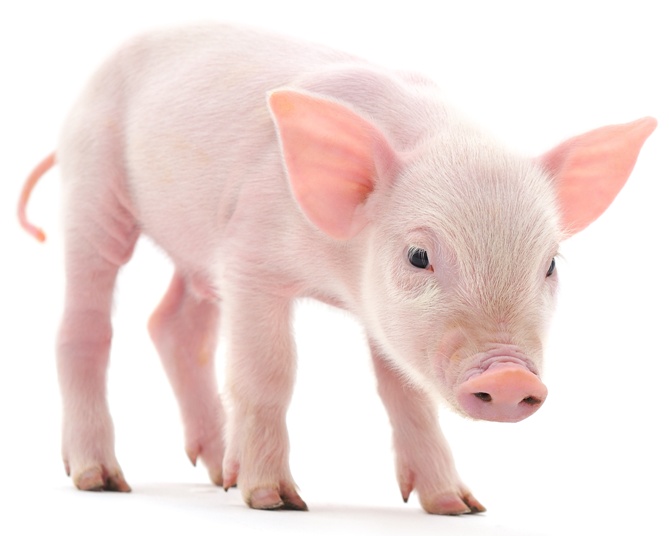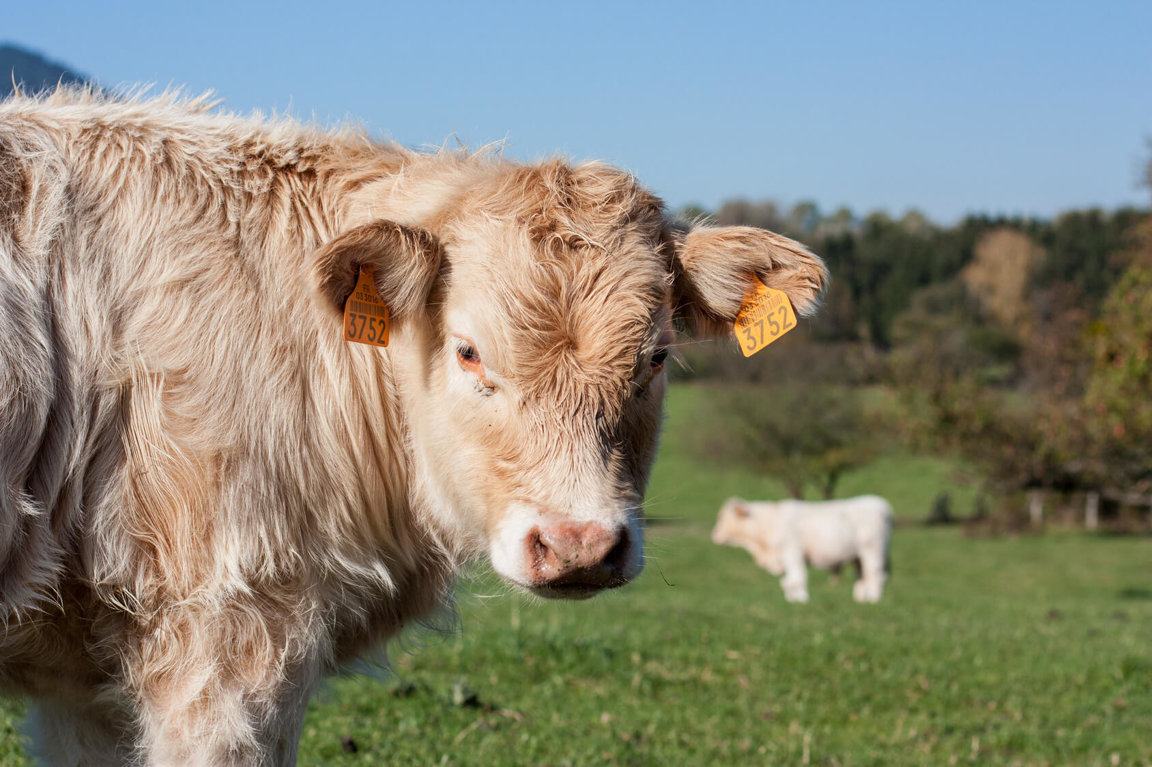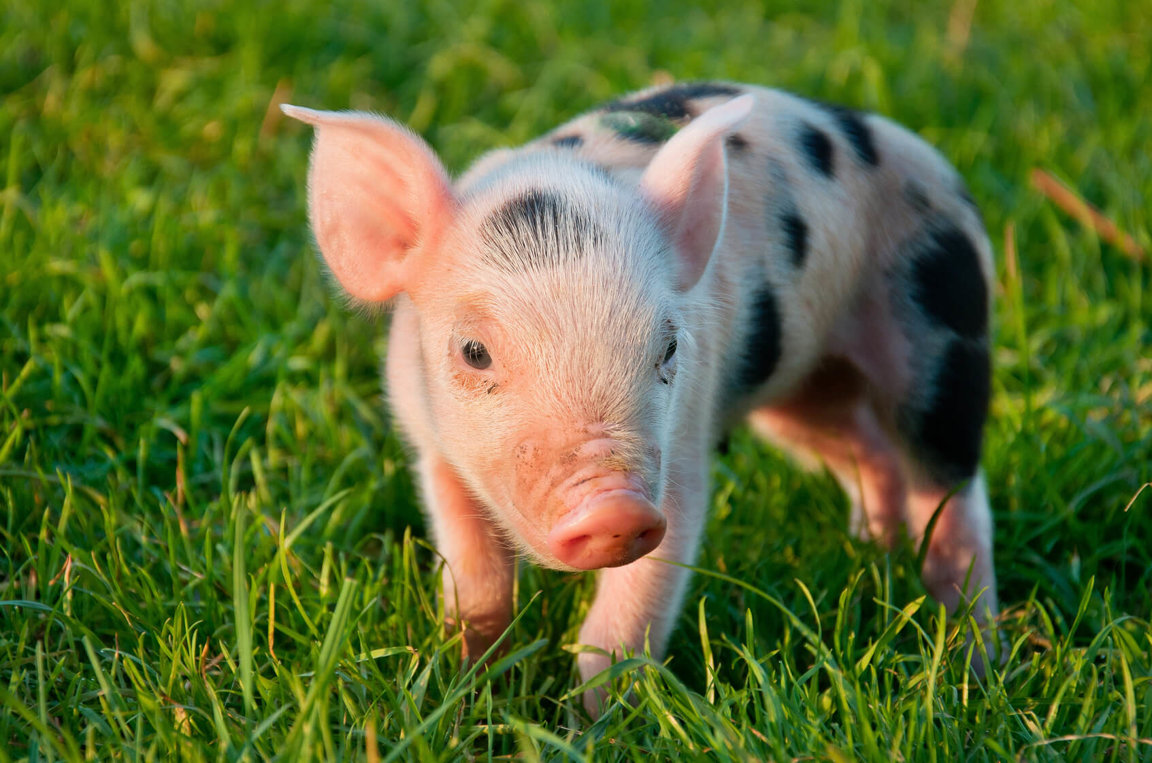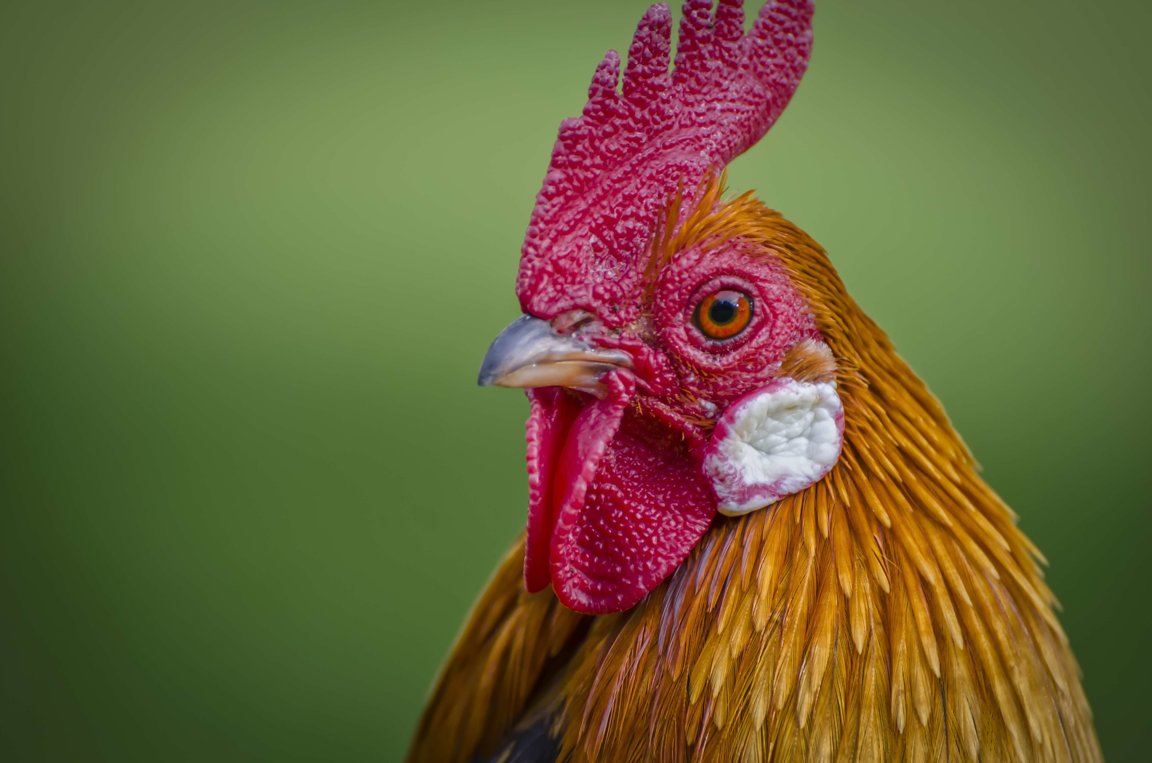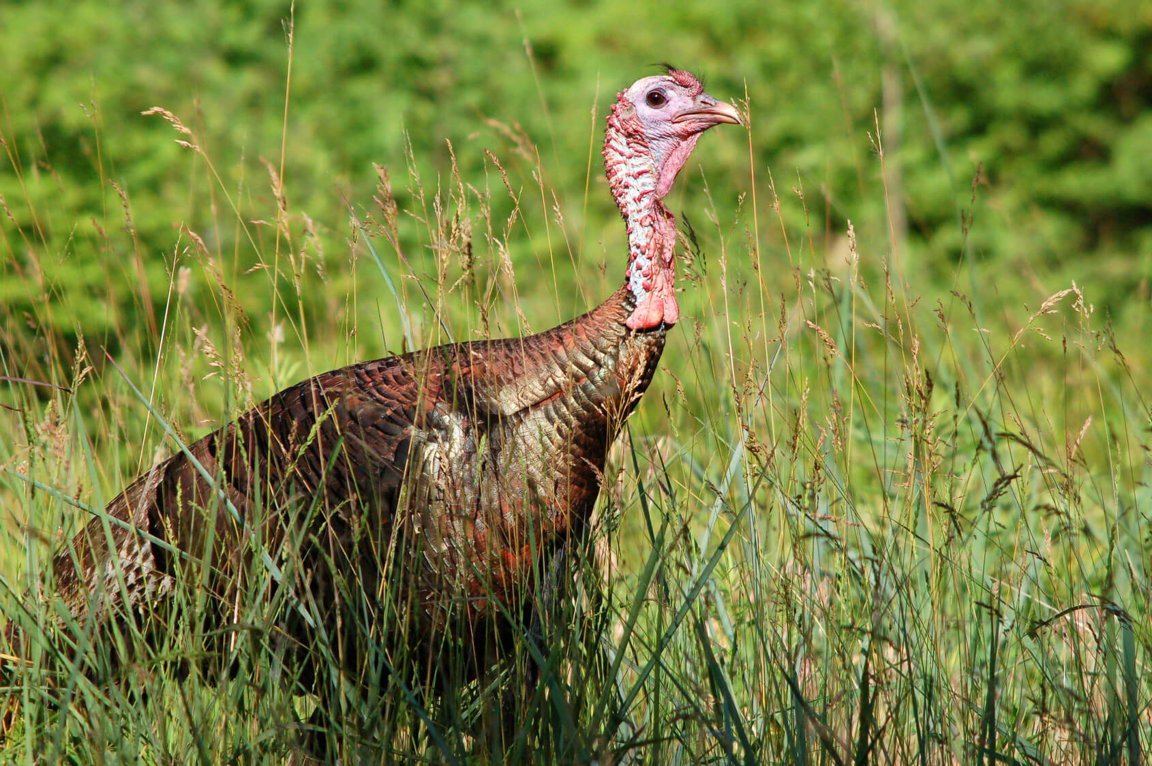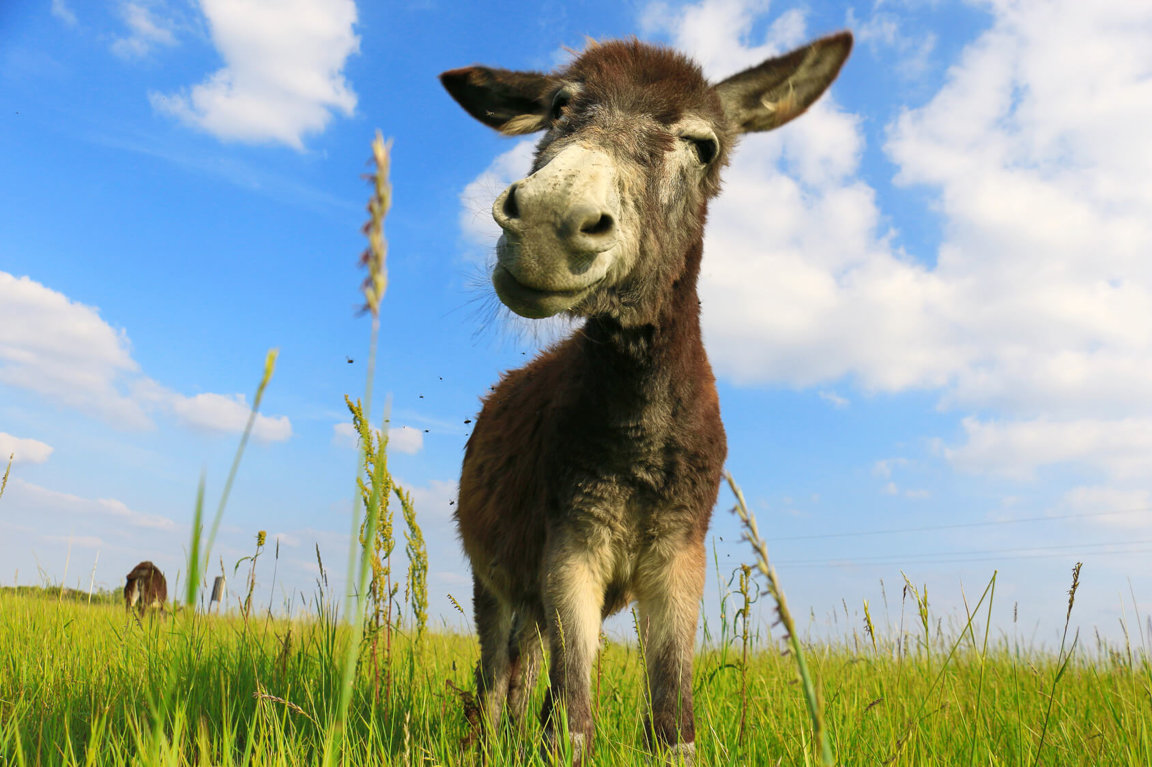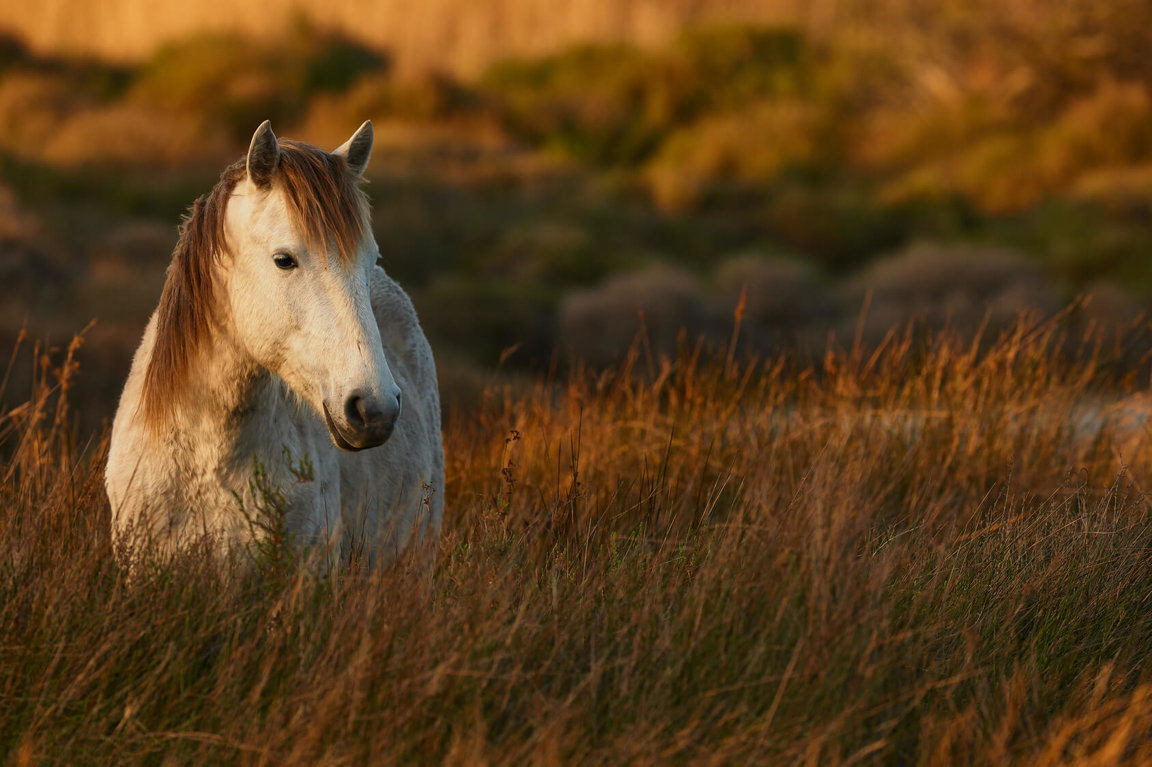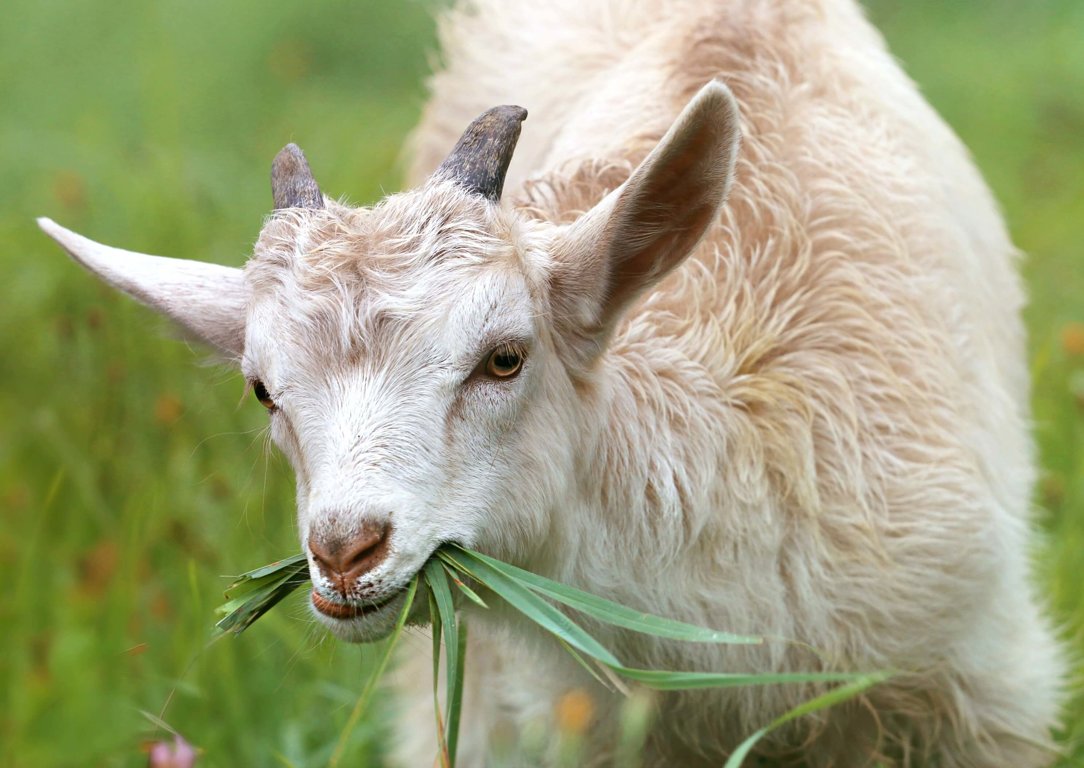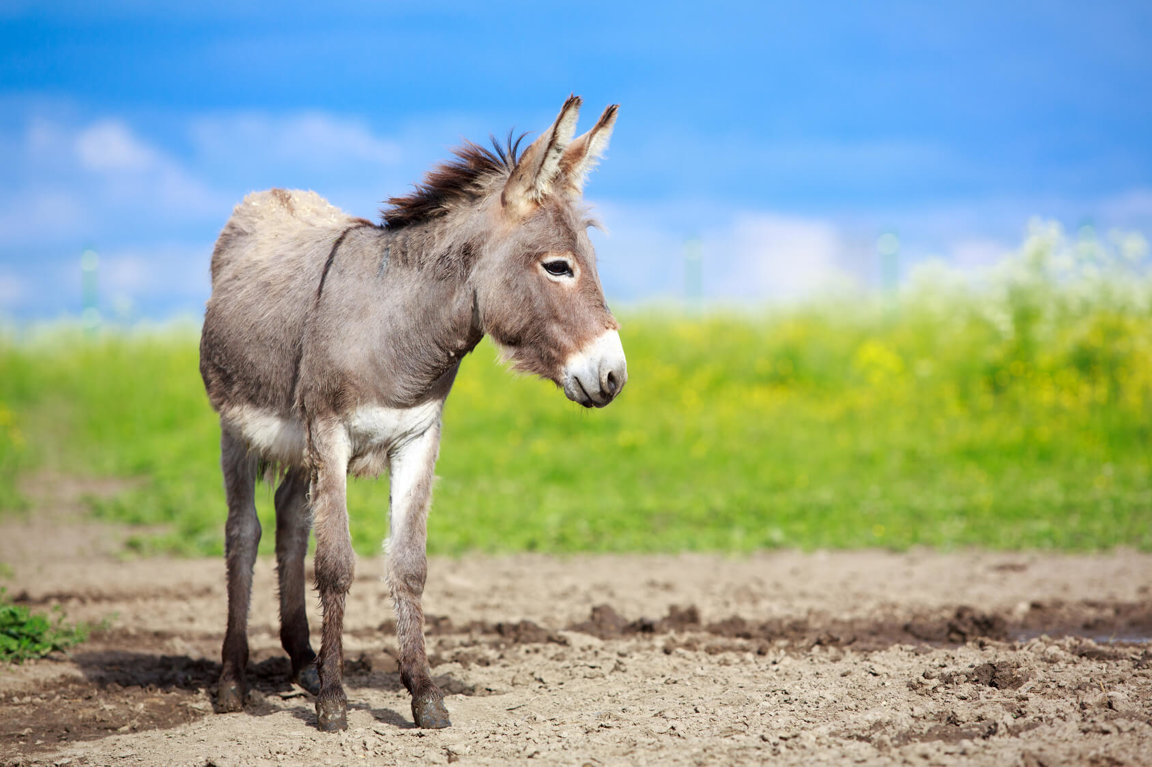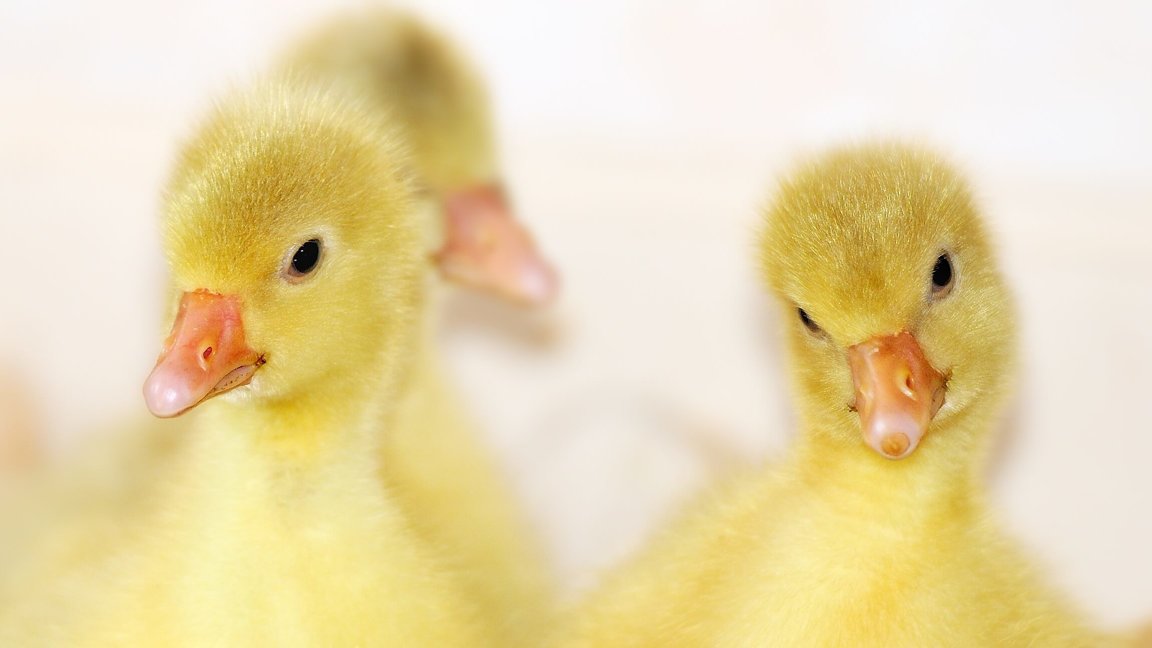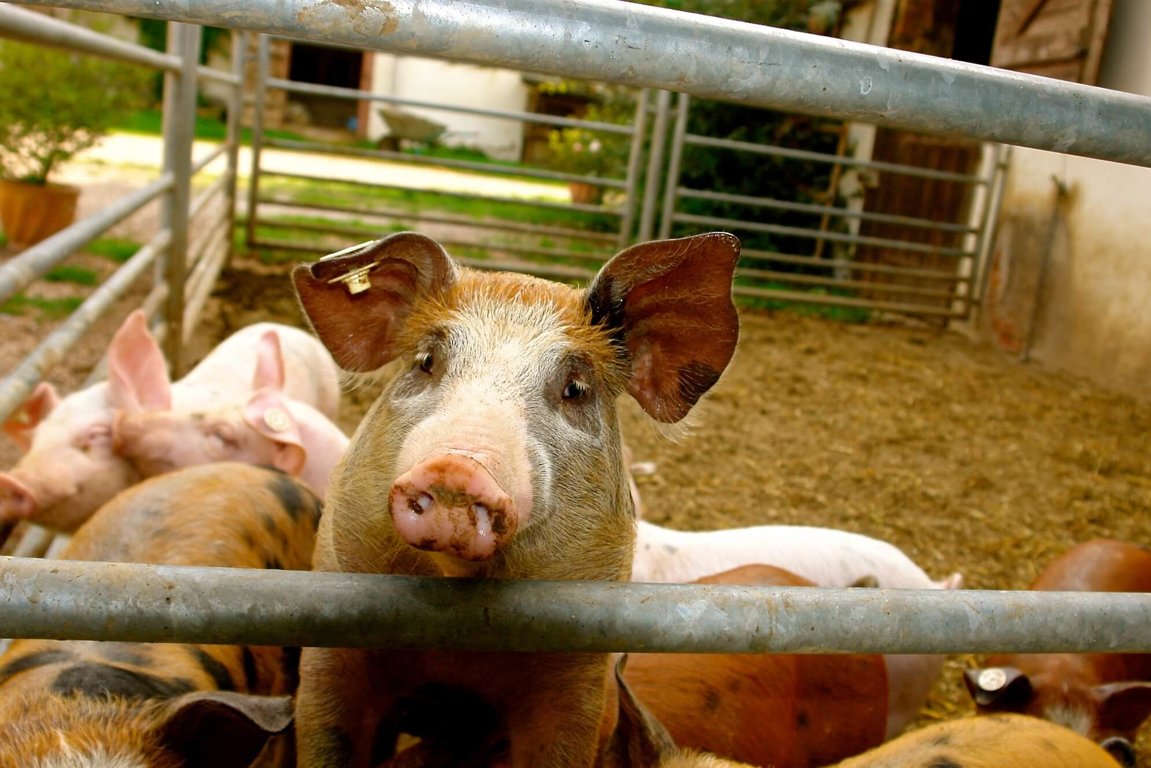Understanding how animals are killed for food is clearly not a pleasant subject. However, all consumers have a right to be aware of how animals farmed for food production are killed, and to understand the extent of the killing involved, in order to make an informed choice as to whether or not they wish to be a part of it.
The following explains what happens before meat, eggs, dairy and other animal products end up on the supermarket shelves. Each person who rejects animal products and goes vegan makes a huge difference.
You can give this story a happy ending; go vegan and experience for yourself a lifestyle that is kinder to animals, people and the environment.
COWS
Meat
Cattle are gregarious animals who, in a more natural environment, would live in complex social groups. They would choose a leader and form close friendships, grooming and licking one other to show their affection. Cattle-farming upsets this hierarchy in many ways, because new members and divisions of the herd occur frequently and this can be very disruptive.
Conditions
Cattle bred for beef may be kept in a variety of systems. Frequently they are kept in windowless fattening sheds until ready for slaughter. They have little room to move and no access to the outside, to feel fresh air and sunlight.
How They Are Killed
Cattle are stunned by a shot into their brain from a captive-bolt pistol. Frequently they struggle or move around because they are terrified by the situation, so sometimes the bolt misses the mark and the cattle are not stunned. Thus they are conscious while being killed by having their throat slit and bleeding to death.
Leather
Purchasing leather ensures the continuity of a massive industry based on animal suffering. The leather industry makes a huge profit each year, mainly from cattle and calf skins.
Artificial Insemination
Most cows are now artificially inseminated. The cow is tied up and one hand of the inseminator manipulates the cervix through the rectum wall while the other discharges semen into the vagina and cervix using an inseminating gun. This is uncomfortable and stressful for the cow.
DAIRY
Both the mother and calf suffer greatly at the hands of the milk industry.
The Mother
Dairy cows have been selectively bred to produce ten times more milk than they would naturally need to feed their calves. This can lead to mastitis, a painful udder infection, and lameness when they are forced to stand all day in the cow shed. In order to produce milk the mother must be kept continually pregnant. So three months after she has given birth, and while she is still producing milk, she will be made pregnant. This puts a huge strain on her. Moreover, the calf is taken away soon after birth so that any milk produced by the cow can be sold for humans to drink. The mother and calf form a strong bond very quickly and the cow continuously calls after her calf has been taken away from her. The separation also causes a lot of confusion and distress for the calf. The cow is put through this heart-breaking and exhausting procedure not once, but an average of five times, until she is deemed to be no ‘use’ to the farmer and killed.
The Calf
The calf is usually disbudded, whereby a heated iron is applied to the horn buds to stop the horns from growing. This is painful and stressful. Male cattle are also castrated by methods that cause the animal acute pain. Female calves are often kept to produce milk. Male calves are usually sent abroad for veal or deemed ‘useless’ and killed.
Organic Milk
On organic farms the dairy cow still has to deal with continual pregnancies, and the mother and calf are still separated very soon after birth. Castration and disbudding of calves may still be carried out, and, as on nonorganic farms, slaughter is inevitable.
SHEEP
Meat
Sheep are social herd animals who tend to be gentle and passive. They have been found to feel desolate when those close to them die or are sent for slaughter. When farmed for their flesh and wool, sheep are exposed to a series of stresses and abuses throughout their lives.
Castration
Lambs are castrated with a rubber ring around their testes or by having them cut off with a knife, usually without anesthetic.
Tail-Docking
During this mutilation the lamb’s tail is usually removed by means of a tight rubber ring, though a knife or hot iron may be used. Again anesthetic is rarely used. Sheep are also put through a barrage of other stressful procedures including artificial insemination, force-feeding, dipping and spraying.
Killing For Meat
Sheep are usually slaughtered by electrical stunning followed by having their throat slit. However, stunning is not always effective and sheep may regain consciousness when their throats are slit or while blood is being drained from their body, a terrifying experience.
Wool
The wool industry is a massive profit-making industry in itself. As well as all the cruelties involved in rearing for meat, the additional practices of mulesing and shearing cause even greater suffering to sheep used in wool production.
Mulesing
This is a practice carried out across Australia, where most wool comes from, and it was introduced to reduce the risk of fly-strike. Fully-conscious lambs have chunks of flesh sliced from their back end. The lamb may be in excruciating pain and left with a wound that takes weeks to heal.
Shearing
This is also extremely stressful with the sheep being forcibly restrained as workers rush to shear them, and bloody injuries often occur. One worker reported, “I have seen sheep with half their faces shorn off”. In Australia alone, an estimated one million sheep die every year from exposure after shearing.
Live Export and Transport
Current methods of transporting sheep are extremely crude and present a number of welfare concerns. During loading and unloading, frightened or tired sheep are not treated with sympathy. Instead they are pushed and hit by stockmen. This certainly causes unnecessary fear in the animals and may also cause them to slip or fall, resulting in cuts, bruises and even broken bones. While being transported, sheep are crammed in with not even enough space to turn around. On journeys that may last days or even weeks, conditions are often appalling. Sheep may suffer from starvation, dehydration, injury and disease and any that fall to the floor are usually crushed to death. Many die before reaching their destination.
POULTRY AND EGGS
Chickens can be very sociable. They enjoy sunbathing and, like turkeys, love to dust-bathe in order to keep clean. As with other birds, mother hens’ desire to build a nest for their young is very strong. They have a strong bond with their chicks which begins even before they are hatched, with the chick and hen calling to each other. In the wild ducks and geese spend much of their time swimming and flying and may travel for hundreds of miles during migration. Geese choose one partner who they stay with for life through thick and thin while ducks live and sleep in groups.
The Life of a Broiler Chicken and Other Birds ‘Grown’ for Meat
On factory farms these birds are taken from their mothers before birth, thus being denied most of their natural types of behavior. No water is provided for ducks and geese to swim in and there is no chance for hens and turkeys to dust-bathe. They are crammed into sheds where the stench of ammonia from their droppings is intense and often leads to respiratory problems. Selective breeding means that these young birds grow very fast. Their bones have no time to become strong enough to hold their weight, so many birds have broken bones and most have lost the ability to fly. An investigation by Compassion in World Farming found crippled birds in chicken farms unable to reach food and drink, carcasses trampled by live chickens and piles of decomposing bodies left to rot.
The Killing
Birds are commonly hung upside down in shackles by their feet and passed through a bath of electrified water, which should stun them before their throats are slit. The birds are killed at the rate of 8-10,000 per hour and left to bleed to death.
Egg Production
Most laying hens are kept in battery cages with several birds to one cage. The amount of room in which each bird spends her life is roughly the same size as a sheet of paper or a microwave oven. In these conditions hens often fight. To prevent this they are de-beaked by having the tip of their beak sliced off. This is an agonizing procedure which leaves the hen in pain for days. It has been found that hens who have been de-beaked avoid using their beaks except for feeding. Privacy is very important to an egg-laying hen but is utterly denied to her. Her desire to make a nest is also very strong, but again this is simply not possible.
Other alternatives are free-range and barn systems but each creates its own welfare concerns. For example, in free-range and barn systems there is more aggression leading to greater feather-pecking and cannibalism. Just like hens in battery cages, free-range and barn hens are often de-beaked. As in the battery system, half of all chicks are gassed at a day old because they are males and hence no good for egg-laying.
FISH
Fish and Pain
Not only do fish feel pain, they are very sensitive to stimuli. Some of their senses are far more developed than ours. Fish are highly responsive to touch and have an incredible sense of smell. They have sensory hairs along their backs that allow them to detect gentle currents and vibrations and sense the motion of other animals. Like other animals, fish use the sensation of pain to help them survive. It tells them when they have entered a dangerous situation from which they should withdraw immediately. It is pain that motivates a fish to fight vigorously when hooked, in a desperate attempt to get away.
Net Losses of Life
Various types of nets are used in sea-fishing, including drift nets and bottom trawls. Drift nets may be over two miles long. Fish that swim into the net become trapped by their gills when they try to back out. Marine mammals, such as seals and porpoises, also become trapped and drown when unable to reach the surface to breathe. Bottom trawls are dragged over the seabed and, as well as fish, catch every other species living on the seabed.
The Way They Die
As the fish are dragged from the ocean, they experience decompression which often causes the eyes to pop and the swim bladder to rupture. Many are crushed to death under the weight of other dying fish and those that survive are left to suffocate when removed from the water or may be gutted alive.
Fishing Has Devastated the Oceans
The United Nation’s Food and Agriculture Organization estimates that all seventeen of the world's major fishing areas have either reached or exceeded their natural limits, and nine are in serious decline. Overfishing has an impact on whole ecosystems since other fish, birds, marine mammals and smaller organisms that depend on fish to survive are affected.
Fish Farming
The rearing of farmed fish can be compared to other types of factory farming. With very limited space the fish can barely exercise and injuries to the snout and fins are common. These are generally caused by rubbing against the net or by collision or aggression between fish. Wild salmon migrate over hundreds of miles and this is completely frustrated by keeping them in the small, static cages that fish-farming involves. The stocking density of salmon is equivalent to keeping a two foot salmon in a bath, while trout have even less space to move.
Killing
Before slaughter, fish are starved for up to three weeks. They may then be killed by electrocution, by a blow to the head with a club or by being frozen to death on ice. Alternatively, the fish’s gill arches are cut or torn and life is literally drained as they are left to bleed to death in the tank. Fish-farms may be rife with disease so large quantities of chemicals are used in an attempt to control it. Ironically, fish-farming also affects wild fish who are fed to farmed fish such as salmon, trout and cod. It takes up to three tons of wild fish to produce one ton of farmed salmon, and up to five tons to produce a ton of farmed cod or haddock.
The True Cost
Few consumers realize that the true cost of cheap salmon includes the deaths of millions of other animals who are seen as predators. Birds, seals, mink, otters and many other animals are killed by the fish-farmers.
PIGS
Pigs are sociable, tactile and inquisitive animals. They like to roll in mud to keep cool and protect their sensitive skin from the sun. They are very clean and, given the chance, they will always keep their ‘latrine’ separate from their living quarters. In a more natural environment the sow would build a nest up to three feet high for her babies. In the factory farm the sow is given a concrete floor with no straw and the nesting instinct is totally frustrated. The pregnant sow will nose at straw that isn’t there to make a nest she’ll never have for another litter she’ll never raise. The sow can barely move and often ends up crushing some of her piglets. In the wild the sow constructs the nest so that crushing cannot happen, but in the factory farm the death of many piglets in this way is almost inevitable.
Piglets
The sow’s piglets are taken away after three weeks, causing great distress to mother and babies. The piglets are still reliant upon their mother at this time, and in a natural environment would still be suckling. Most piglets have their teeth clipped and tails cut off to stop them from fighting and tail chewing. They are put into small pens or metal cages, and after about six weeks go to fattening pens where they have little room to move and never see fresh air. Their intelligent, enquiring minds are dulled down by boredom and total lack of stimulation.
Slaughter
Pigs to be killed are stunned with electric tongs or gas, hoisted up by one leg and have their throats slit. They are then put into a tank of boiling water to remove their bristles. Many pigs regain consciousness before they die from loss of blood. There are reports of pigs being boiled alive because they had not been stunned properly.
HONEY, SILK AND SHELLAC
Honey, silk and shellac are produced using bees, moths and lac insects respectively. Being such tiny creatures, their needs are often overlooked. This is very unfortunate because thousands are required to yield a small amount of honey, silk or shellac.
Honey
Bees are social insects who live in a well organized colony. They work together to keep the colony running smoothly, protecting and feeding one other and undertaking many other tasks together. In commercial honey production, bees undergo treatments similar to those used in factory farming. Whole colonies of bees may be killed to save feeding them during the winter, and the queen bee has her wings clipped and is artificially inseminated with sperm from decapitated male bees. Beekeepers take the bees’ honey, and to replace it often feed them artificial pollen substitutes and white sugar syrup. The honeybee flies about 500 miles in her working life and produces half a teaspoon of honey. Much of this is taken away.
Silk
This is produced by silkworms. A silk cocoon is spun by the silkworm caterpillar by manipulating a thin silk thread in a figure of eight movement some 300,000 times. Once the caterpillar is ready to turn into a moth, she must break down the cocoon in order to emerge. This process would destroy much of the silk, therefore the majority of the moths are killed by being immersed in boiling water or dried in an oven. It takes literally hundreds of silkworms to make just one small silk scarf or tie.
Shellac
This is a secretion produced by Lac insects as a protective coating. The secretion is scraped off the trees on which they live and turned into shellac. Some of the insects are scraped off at the same time and die.
